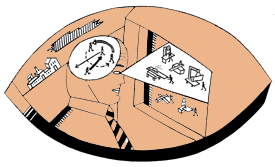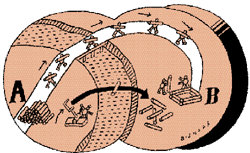Emergent Leadership: Bringing Free-market Risks and Rewards to Command-and-Control Corporations
(originally published by Booz & Company) The free market often seems better at recognizing and promoting leaders than large organizations. Mavericks such as Bill Gates of Microsoft and Howard Schultz of Starbucks, who may not have fit easily into established companies, succeeded at building their own corporate empires. They, and others like them, stand out as heroes at a time when blue chips seem to be losing ground to entrepreneurial companies.
The free market often seems better at recognizing and promoting leaders than large organizations. Mavericks such as Bill Gates of Microsoft and Howard Schultz of Starbucks, who may not have fit easily into established companies, succeeded at building their own corporate empires. They, and others like them, stand out as heroes at a time when blue chips seem to be losing ground to entrepreneurial companies.
Most of the job growth in the United States this decade has come from small companies, according to Cognetics, a research organization. Executives of some large corporations, trying to recapture some of that dynamism, know that their staffs must become more entrepreneurial so that future leaders can be spotted early and supported.
A theory called emergent leadership, which introduces some of the dynamics of the free-market system to corporate management, may help. It tries to eliminate the office politics and uneven power distribution that can distort corporate operations.
Advocates of the emergent-lead-ership model reject the autocratic command-and-control structure favored by traditional companies in favor of a more free-wheeling approach. They argue that if workers are given enough decision-making power, even at the lowest ranks, natural leaders will bubble to the top. Central to the concept is the conviction that companies must recognize and nurture the creativity inherent in their employees, including both the "knowledge workers" valued more for brains than brawn and the factory workers.
John Trani, chief executive officer of Stanley Works, a specialty hardware group, likes the concept but realizes that managing innovation is not as easy as it may sound. "Corporations need to encourage more experimentation among their workers," Mr. Trani says, "but that's not easy to do."
One way to approach the challenge is, in a manner of speaking, to let creativity manage itself. Use of the emergent-leadership concept fosters a democratic, rather than autocratic, approach to problem solving; it strives to eliminate a corporation's hierarchical structure and encourages a system that borrows ideas from the marketplace. The emergent leadership model encourages innovative ways of thinking by giving employees free rein to prove the value of their ideas and skills.
Gore & Associates, the maker of innovative fabrics including Gore-Tex, is a good example of a company that has embraced emergent leadership. Gore's top executives rarely appoint managers; instead, workers choose their leaders. These leaders head up both static and project teams. The static teams are responsible for the day-to-day operations of the company and include factory-floor workers. Project teams are assembled when needed for specific tasks such as fabric development or upgrading the computer systems.
Static team members elect their leader in an informal vote. Project teams evolve from worker initiatives. When Gore employees think they have a good idea, they try to rally colleagues behind their plan. If enough people join in the crusade, a project team is born. Usually the person who conceived the plan takes control, although the team may decide to place someone else in the management position. Any worker can try to become a team manager. Like independent entrepreneurs, people with ideas at Gore succeed by getting others to believe in their projects. They enchant colleagues with their vision of the future.
The emergent leadership model is part of a larger management philosophy called self-organization within complex systems -- or "complexity theory" for short. It argues that order and creativity form naturally in systems left to their own devices. Managers should not try to control every detail of the operation but allow workers to manage themselves.
Examples of leaderless self-organization are found in nature. Birds flying south for the winter do not follow a single head bird when they form a v-shape; they may each take their turn up front. Similarly, ants in a colony get messages from other ants to organize their work; they do not look to a head ant for instructions or directions.
If creativity and order emerge with relatively little effort, are leaders needed at all? Yes, to prevent the system from collapsing into chaos. Complexity theory holds that near-chaos is the most active and most creative state. Corporations, however, must be careful. Danah Zohar, the author of "Rewiring the Corporate Brain," a recent book on corporations and complexity, cautions that "operating at the edge of chaos is very different from falling over the cliff."
The role of senior managers in self-organizing systems, therefore, is subtle but important, starting with deciding which people to include in the organization.
Nigel Morris, chief operating officer of Capital One, a credit card issuer, says, "My most important function is identifying which organisms will thrive in our corporate ecosystem." Mr. Morris spends at least a quarter of his time recruiting. He and his partner, Richard Fairbank, conducted 2,000 interviews last year, and made 30 job offers. "We want to find young stars, bring them into the organization and let them go," Mr. Morris says.
Defining the rules within self-organizing systems is essential because it is the rules that prevent the company from falling over the edge. The challenge is to establish a corporate culture strong enough to allow creativity to flourish while keeping the company from spinning out of control.
It is tempting, in a strong corporate culture, to see even petty controls as essential. For a long time, the International Business Machines Corporation demanded that its executives wear only dark suits and light shirts. Clothing retailer Abercrombie & Fitch regulates the type of earrings store workers may wear and how many sweaters may be stacked on a pile. At Calvin Klein offices, flower vases must be filled only with white calla lilies.
Jerry Porras, a management theorist, argues that "corporate culture should be what a corporation would give up at the last gasp." He defines it as "the core values that employees feel in their gut, not just their head." These should include such things as a strong commitment to ethics, a drive to please customers and respect for fellow employees -- not shirt colors and fiower arrangements. Ms. Zohar asks in her book: "How can you encourage creativity and self-expression if your employees can't even choose what type of fiowers to have on their desk?"
While some organizations fail by being too conservative, a few drop into chaos. Many management analysts would say Apple Computer crossed over this line in the early 1990's. It may also have happened in the Clinton White House.
In their book, "Organizing Genius," Warren G. Bennis and Patricia W. Biederman describe President Clinton's first Presidential campaign as an example of creative management well-executed. Campaign workers had a strong vision and followed some well-established rules. For instance, the phrase, "It's the economy, stupid," was scribbled on the blackboard at campaign headquarters every morning to remind volunteers of the campaign's focus. Yet workers were given relatively free rein in accomplishing their tasks. Once the President moved into the White House, the authors wrote, the rules and vision disappeared and the staff had no clear goal. Leon Panetta, who took control as chief of staff in 1994, describes the confusion:
"It was like a high school soccer team, with everyone going for the ball at once, and no one providing support. Everyone was a general, gathering around the issue of the week, and not attending to other business. There was no formal chain of command. Staff walked into the Oval Office whenever they felt like it, just to shoot the breeze. They didn't understand that time with the President is a scarce resource."
The remedies: a strict chain of command with workers assigned to specific tasks, a Presidential appointment calendar, a requirement that memos be prepared listing possible options before attending meetings. Complexity advocates would say that the remedies went too far. "I don't know how President Clinton or his staff could be very creative, operating under such a strict system," says Ms. Zohar. Others argue that the remedies saved the White House from chaos.
 Fear of chaos leads most companies to keep tighter reins with good reason or at least common sense. Employees need to be held in check. A worker who does not follow a company's basic rules can be dangerous. In one of the most extreme cases, a rogue trader, Nicholas W. Leeson, brought a British investment bank, Barings Bank, to the brink and then pushed it over. Anyone would argue that corporations need to protect themselves from workers gone awry.
Fear of chaos leads most companies to keep tighter reins with good reason or at least common sense. Employees need to be held in check. A worker who does not follow a company's basic rules can be dangerous. In one of the most extreme cases, a rogue trader, Nicholas W. Leeson, brought a British investment bank, Barings Bank, to the brink and then pushed it over. Anyone would argue that corporations need to protect themselves from workers gone awry.
There may be ways to encourage experimentation while reducing its risk, providing checks and balances without squashing creativity.
Mr. Morris of Capital One knows how companies can destroy dreams. A decade ago, he set out to change the credit card industry. "In those days, credit cards were very limited," he says. "They were tied to MasterCard or Visa, offered almost exactly the same interest rates and were available in any color as long as it was black."
Mr. Morris wanted to give consumers some choice. By offering varying rates, card fees, payment options and other services, he felt he could revolutionize the market and gain a large share of customers. He shopped his idea to the top 20 banks in New York. They all refused to back the project. "The strange thing is that some of them felt it would work, but they felt there would be too much bureaucracy in getting it approved," he recounts.
Eventually, Mr. Morris found a taker in the tiny Signet Banking Corporation in Richmond, Va. Under Mr. Morris's management, the bank became the 10th largest issuer of credit cards in the country; the division was spun off last year to create Capital One.
Mr. Morris says he struggles with the challenge of nurturing entrepreneurs while making sure his own achievements are not constantly threatened. To strike a balance, he encourages mass experimentation, yet contains risk by limiting the experiments initially to small-scale projects.
Capital One used this approach two years ago in deciding to set up an operation in London. "A lot of people told me the English would not be interested in our products, because they were used to dealing with big name banks that they knew and trusted," says Morris. "But a group of employees here told me they wanted to give it a try." Mr. Morris set up a six-member team in London. By outsourcing almost all operations, including billing and collections, the group could function with very low overhead. The experiment turned out to be a success, with a response rate that Mr. Morris says was beyond his highest expectations. Capital One is now building a full-scale British credit card operation.
Small-scale experiments may be a good way to let fiedgling leaders prove themselves, yet most companies are more than just a collection of projects. Someone has to oversee day-to-day operations. Companies operate on thousands of small decisions. Yet it is not always clear who should make those decisions, or who has made good decisions in the past. Corporations often complain that it is difficult to assess managers' performance and that unless they know which employees are the most capable, they have a hard time working out which to turn into leaders.
Senior managers may have only the most superficial knowledge of the skills and performance of low-level employees; their time is often scarce, and it becomes more so as the organization grows. That is why Gore & Associates places much of its promotion power in the hands of its workers, who have a more profound knowledge of their colleagues' skills.
Or do they? For democracy to work well, say managers, the voters need access to good information about the candidates. Eric Tomlinson, chief executive officer of GeneMedicine, a biotechnology company, says, "Unless the candidates have been allowed to build a set of credentials within the company, it just turns into a popularity contest."
Workers may also need certain skills themselves to make correct performance assessments. "Think of a panel of Olympic judges," says Mr. Morris. "The audience does not decide who wins the gold medal in diving, for instance, because they don't understand the subtleties of the sport. The panel of judges does. Is it democratic? Yes, but in a different way."
Mr. Tomlinson has chosen to apply the principles of complexity theory in a modified context. Workers must be given the chance to prove themselves, he says, by chalking up small successes. The trouble, in his view, is that most corporations are set up in a way that makes achievements extremely difficult to measure. "The drug development process is often very linear," says Mr. Tomlinson. "Products move from research to development to clinical trials and to market. In the end, it is difficult to say who is really responsible for the success."
Mr. Tomlinson has responded by carving out niches of responsibility within the corporation that clearly allow achievements to be recognized. Rather than farming out parts of the same project to teams all over the corporation, Mr. Tomlinson aims to concentrate efforts. As a result, employees feel far more in control; their accomplishments can also be far more readily recognized. "I try to create bite-sized pieces of success that can be celebrated and rewarded," he explains.
Henry Hebel, production manager at GeneMedicine, says this model allowed him to rise at the company far more quickly than he would have at other companies. "The creative part of my job comes in figuring out how to meet very tight deadlines," he explains. When Mr. Hebel had to produce a large amount of plasmid DNA, he relied upon the company's fiexible hierarchy. "I assigned the division head, John Welp, to solution preparation," he says. "That wouldn't normally be the job of a division head, but he understood that I needed to get the job done."
If it is difficult to recognize leaders by spotting their successes, it is even more of a challenge to identify them by their failures.Yet companies say that is what they need to do to encourage entrepreneurship within their ranks. In the larger marketplace, entrepreneurs who fail are not forever condemned to the back burner. More often than not, they move on to other ventures. "I wouldn't want to have anyone near me who hasn't failed," says Lew Platt, chief executive officer of the Hewlett-Packard Company. "To encourage risk-taking, you have to tolerate failure."
Successful entrepreneurs use their failures as important learning experiences that help them become stronger leaders. Making sure failure is not automatically punished demands a strong commitment on the part of senior management. "It's a subtle thing," says Mr. Morris. "You don't want to promote someone who failed because everything was done in a sloppy way, but you do want to look for people who failed because of a single shortcoming that can be corrected."
To compete in today's market, large corporations need to provide workers an environment in which they can make their own decisions and create their own visions. That means letting go of the old command-and-control model in favor of a looser approach. Yet larger corporations have a lot at stake. Giving workers unlimited power, with no rules to hold them in check, is foolish. Employees need to follow a meaningful set of guidelines designed to minimize risks while encouraging creativity.
Senior managers have a large role to play in this balancing act. They need to make sure the workers they hire have the skills necessary to drive the company forward. They must establish a meaningful corporate culture that encourages a sense of entrepreneurship. They have to find ways of encouraging mass experimentation while limiting possible threats to the company's existence. If all goes well, natural leaders will "emerge" to move the organization forward. ![]()
| Authors
Victoria Griffith, Griffgor@aol.com Victoria Griffith writes about technology and management for the Financial Times and other publications. She has an MA in international politics from the Johns Hopkins School of Advanced International Studies. Ms. Griffith is based in Boston. |


